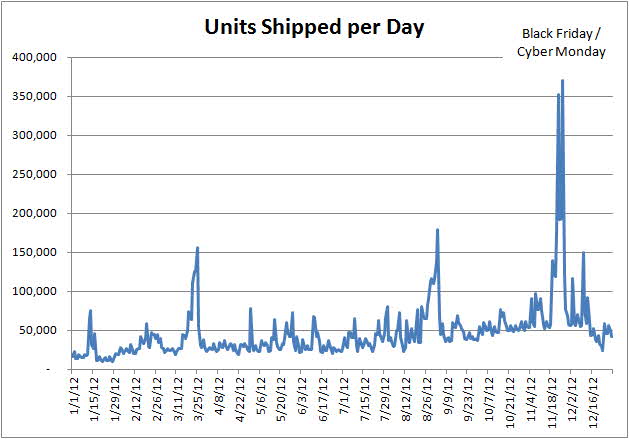|
Introduction
The rapid growth of retail e-commerce is creating serious challenges for supporting retail and wholesale distribution operations. The good news is that growth rates for e-commerce are significantly exceeding expectations for most companies. The bad news is that there are some very stressed distribution operations behind the scenes that are having difficulty keeping up with sales growth. The complexities of fulfilling online orders are now better understood as a result of record shipping volumes being experienced by e-commerce retailers - in some cases exceeding 100,000 units shipped per day.
Differences Between Retail Distribution to Stores Versus Distribution to Online Customers
A few of the key differences between providing distribution support services for a high volume retail web store front versus a traditional retail store network are discussed below:
- E-commerce peak shipping days are sharper, more intense and more concentrated than traditional store order fulfillment.
- The typical e-commerce peak runs between November 1 and December 20 based on the buildup for Black Friday, Cyber Monday and Christmas.
- During this time, it is not unusual to have a peak day : average day shipping volume ratio of 4 - 5 and these surges place tremendous stress on the underlying throughput capacity and staffing requirements for supporting distribution operations.
- The graph below provides a typical example of this phenomenon. Between January 1 and November 1, shipping volumes through the distribution center average approximately 40,000 units per day for this e-commerce retailer. Shipment volumes through the fulfillment center spike by 900% on November 23rd for Black Friday / Cyber Monday (in the U.S.) and then consistently by 150% - 400% for during the month of December for the buildup to Christmas. Other spikes during the year tend to be related to event-driven promotional campaigns.
 |
- Distribution center operations are vastly different for e-commerce order fulfillment as compared to retail store order fulfillment:
- The shipping unit of measure ordered by the consumer is often lower than the unit of measure ordered by the store. For example, an item that is shipped to a store as a master case of 12 retail units is ordered by the consumer as a single retail unit. The retail unit may be a glass item such that it now needs to be taken out of its master case and placed into a shipping carton with protective packaging. If the distribution center supports both retail store and e-commerce channels under the same roof and within the same logical warehouse, then the item may need to be picked from 2 separate pick slots (Each, Case) to support this requirement. Not all retailers have the luxury of having enough real estate to support this requirement so then the situation arises where multiple units of measure are picked from the same bin location which is an invitation to an inventory accuracy nightmare of order of magnitude proportions for larger operations.
- Unlike retail store orders, online orders tend to be small in terms of order lines and units. Order sizes typically range from 1 - 4 items per order. It is not unusual for more than 50% of sales orders to be singles (i.e. one item per order). Companies often achieve efficiency by releasing single-line orders as a separate batch apart from multi-line orders. Single-line orders can be batch picked and then transferred directly to the packing process. Multi-line orders can also be batch picked and then transferred to a sortation process prior to packing. The sortation process can be manual for lower volume applications and this is typically done through the use of a put-wall. For higher volume fulfillment operations, the use of automated sortation systems such as tilt tray sorters, bombay sorters, or cross belt sorters can be used to marry up the multiple order lines within an order prior to transfering the completed order to packing.
- An alternative approach that eliminates the need for sortation systems is the use of goods to person semi-automated picking systems. The most common automation systems being deployed for e-commerce order fulfillment include shuttle systems, the Autostore system, and Amazonrobotics (formerly Kiva and exclusive to Amazon), inVia Robotics, . There are also numerous other upstart companies that have emerged in this space such as Grey Orange (India), Attabotics (Canada), OPEX Corporation, Alert Innovations (USA), Exotec, Fabric, etc.
- The design of an efficient picking and packing operation is critical to the success of an e-commerce distribution center. Intelligent order wave planning, intelligent batch / cluster picking, slotting optimization, and workflow management are useful strategies to improve the efficiency of physically processing e-commerce orders. The use of more sophisticated material handling technologies may be essential to supporting the ability to ship peak order volumes during peak season.
- Some retailers have outsourced their e-commerce fulfillment operations to third party logistics (3PL) companies (e.g. Shopify, eBay, etc.) because the supporting distribution requirements discussed above are so different from what they are used to. The outsourcing strategy has been deployed in many instances for retailers when they first get started with fulfilling orders for the e-commerce channel. The general thinking is that since we are not sure what the demand volumes will be then it is best to start out in a shared 3PL distribution center to minimize our investment and resource requirements. However this strategy has not been entirely successful.
- The 3PL may operate a multi-tenant distribution center where the needs of all clients in the building are more paramount than the needs of any one individual tenant.
- The 3PL’s IT system support capabilities may be lacking in areas that directly and negatively impact productivity levels and throughput capabilities of the retailer's distribution operation. The 3PL may not be willing to invest into system modifications for any one client, particularly if there is a perception that the client may soon be departing due to any performance issues.
- The 3PL may have difficulty handling the sum of all client peak shipment volumes and the result is a major surge in expedited shipping costs to get the order to the consumer on time. Similarly, the retailer may have to issue gift coupons to the consumer as a way of appeasing the customer if the order is shipped late, incomplete, or not at all. Who pays for this liability if the issue is related to poor 3PL performance? The retailer will likely expect compensation from the 3PL for incurring these additional operating expenses. The 3PL is surviving on thin margins and cannot afford to pay for these decisions that are made by the retailer. It’s a potential source of conflict, especially when logistics managers working for the retailer are expected to improve the situation by a management team that may not understand (or want to understand) the details.
- There may be a loss of profit margin and double handling associated with transporting product from an existing retail distribution center to replenish stock at the 3PL distribution center where e-commerce order fulfillment takes place. The 3PL needs to make a profit margin of at least 13% to be in business which also adds to the cost of fulfillment for the retailer.
- Suffice to say that increasingly retailers are now looking at ways to bring e-commerce order fulfillment operations in-house for self-distribution as a means of gaining more control over supporting distribution operations and to increase profit margin on these orders which are increasing as a % of total revenue.
- When the consumer has finished placing products into a shopping cart and no it is time to checkout, the normal process is to submit payment by a credit card or paypal at the time of order placement. This does not necessarily mean that the funds are deducted from the credit card at this time. It means that the funds are frozen or reserved for payment such that the actual funds deduction takes place at the time of shipment.

- If for some reason it is not possible to ship the order line, due to say an inventory discrepancy issue, then the best practice is to cancel the order line from the order and send a communication email back to the customer. If the funds for this canceled line item have been reserved but not deducted then there is no need to credit the customer for the shorted transaction.
- The funds deduction at the time of order placement is especially an issue for international customers who get a double whammy when they pay the credit card company a 2.5% charge for exchange rate when the purchase the product and then they lose 2.5% of the amount when the return is credited due to the short-shipment. Imagine buying a $1000 item online and losing $50 of your hard-earned money because of exchange rate losses that the financial institution gains due to a retailer short shipment. This has happened to me and believe me I was not happy. Conversely, when Amazon advised me that they could not ship an item that I had ordered, they sent an email to advise that the order line was canceled and since the funds had not been deducted there was no financial transaction involved - a much happier customer experience!
- Many retailers sell products on their web store fronts which are not stocked in their distribution center(s). They rely on a network of wholesale distributors and partners to fulfill consumer orders for these non-stock items. This involves a fairly complex set of distribution support requirements:
- The wholesaler needs to reserve inventory for each retailer web store front being supported by submitting a daily EDI file to the retailer to advise on available inventory quantities by SKU. This is because retailers generally want to avoid having an item for sale on the Web store front when stock levels drop below a certain threshold. This reservation may cause channel conflict for the wholesaler whereby store orders for products are being shorted out because the inventory has already been reserved for retailer web store fronts. This hurts the wholesaler's business because a guaranteed sale is being canceled when the inventory is sitting on the shelf unallocated to a Web order. If the wholesaler decides to sell the item and then short out the Web order that may come in afterwards then they face a retailer non-compliance fine.
- The wholesaler must often fill the consumer order on behalf of the retailer so that it is transparent that they were involved in the transaction. This may involve multiple retailer-specific compliance requirements such as provision of pricing, tagging, invoicing, and shipping paperwork. There may also be a requirement to support value added services such as gift wrapping, special packaging to conceal the product if it is a gift item, special protective packaging for breakable products that normally ship in case quantities, special outbound parcel shipping requirements. On the reverse logistics side, the management of returns will most likely flow back from the consumer to through the retailer's distribution center(s) and then to the wholesaler in peak volumes often experienced during the month of January.
- The consumer typically wants their order within 3 - 5 days of placement which means same-day order fulfillment in the distribution center. Not all wholesalers are geared up to respond to this order cycle time because they operate on a single shift on weekdays only. What happens if the wholesale distributor ships the order 2-3 weeks later? This reflects badly on the retailer since the order was placed on their web store front. What if there is cross-border sourcing required with customs, duty and border clearance requirements? This may extend the lead time to the consumer which needs to be communicated up front when the consumer is shopping on the Web site.
Conclusions
This article point outs that underneath the glossy veneer of the e-commerce, there is a world of challenges being faced by retailers and wholesale distributors alike, particularly with companies that service both retail stores and web consumers. Supporting distribution requirements for e-commerce order fulfillment are vastly different than providing support for retail stores. Getting it right may require different IT systems, strategies and infrastructure to handle the surges in volume and anticipated growth for the online retail channel.
Marc Wulfraat is the President of MWPVL International Inc. He can be reached at +(1) (514) 482-3572 Extension 100 or by clicking here. MWPVL International provides consulting services to help retailers achieve logistics excellence with their e-commerce fulfillment centers. Our services include: distribution network strategy; distribution center design; material handling and automation systems; 3PL outsourcing; supply chain technology consulting; product sourcing and purchasing; transportation consulting; and operational assessments.

|